If you’re looking for the best STEM kits that turn learning into fun, I’ve got great options to share. From snap circuits that teach electronics basics to science kits with experiments like volcano eruptions and crystal growing, there’s something for every kid’s interest. Robotics, renewable energy projects, and artistic construction kits are also fantastic. Keep going to discover which kits match your child’s age and skills to inspire curiosity and creativity in STEM.
Key Takeaways
- The list features diverse STEM kits in electronics, science, robotics, and building projects suitable for children aged 6-13.
- Each kit promotes hands-on learning, creativity, critical thinking, and problem-solving skills in a fun, engaging way.
- The options include beginner-friendly kits with clear instructions and advanced kits for more experienced young learners.
- Safety, durability, and educational value are prioritized to ensure a positive and safe learning experience.
- The kits support independent exploration, fostering curiosity and a love for STEM subjects through interactive projects.
Snap Circuits Jr. SC-100 Electronics Exploration Kit
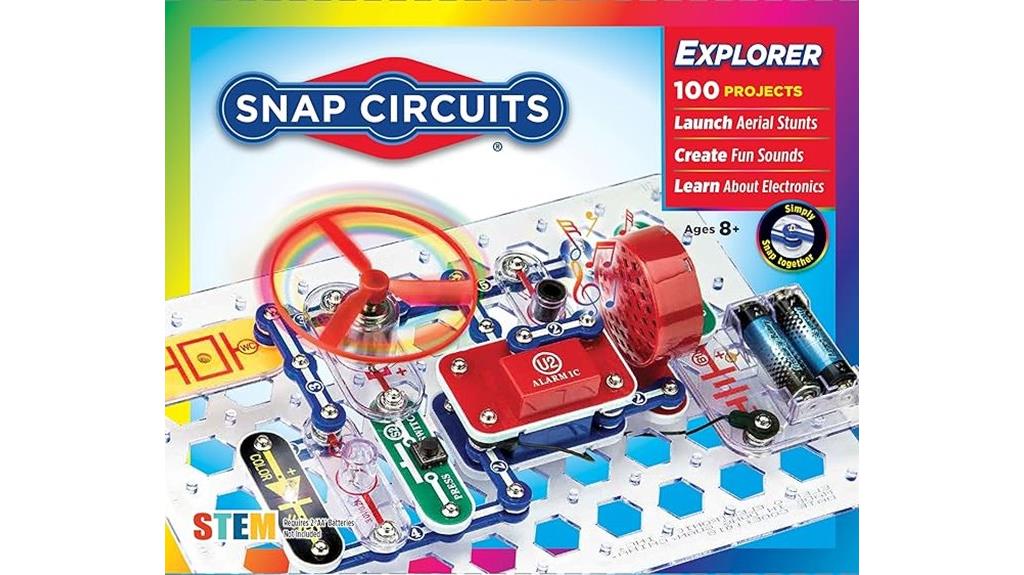
If you’re looking for a safe, engaging way to introduce kids aged 8 and above to electronics, the Snap Circuits Jr. SC-100 is perfect. I love how it includes colorful, real circuit components that snap onto a plastic grid without tools or soldering. Kids can build over 100 projects, from flying saucers to musical doorbells, guided by a clear, picture-rich manual. The kit promotes hands-on learning, from basic switches to complex digital circuits, encouraging experimentation and problem-solving. It’s durable, safe, and expandable, making it ideal for beginners and growing engineers alike. Plus, it’s highly rated and recognized for its educational value.
Best For: children aged 8 and above who are interested in learning basic electronics through safe, hands-on activities.
Pros:
- Includes over 30 colorful, real circuit components that snap easily onto a plastic grid without tools or soldering.
- Offers more than 100 engaging projects that promote creativity, problem-solving, and understanding of electronics principles.
- Highly rated for durability, safety, and educational value, with positive reviews from many satisfied users.
Cons:
- Requires two AA batteries (not included), which may be an extra purchase for some users.
- The set might be limited for advanced learners without additional upgrade kits or higher-level sets.
- Some users might find the manual’s instructions too simple once they master basic projects, needing additional resources to challenge more experienced kids.
National Geographic STEM Science Kit with 15+ Experiments

Looking for a STEM kit that truly engages young scientists with hands-on learning? The National Geographic STEM Science Kit offers over 15 exciting experiments, like crystal growing, volcano eruptions, and gemstone digging. Designed for kids 8 and up, it’s perfect for family or classroom use, with clear instructions and an educational guide explaining the science behind each activity. The high-quality materials and variety of experiments keep children curious and confident as they explore Earth sciences. With a strong reputation and a 4.7-star rating from thousands of reviews, this kit makes learning fun, inspiring a lifelong interest in science.
Best For: young science enthusiasts aged 8 and up, families, and educators seeking engaging and educational STEM activities.
Pros:
- Offers over 15 hands-on experiments that make science fun and accessible
- Includes a comprehensive educational guide to deepen understanding of Earth sciences
- High-quality materials and organized components promote durability and ease of use
Cons:
- Some users have experienced minor issues like stiff magnetic putty or missing gemstones
- The size and weight (8.66 x 3.15 x 12 inches, 2.61 pounds) may require dedicated storage space
- As an Amazon-exclusive, availability might be limited in some regions
Sillbird 12-in-1 Solar Robot Building Kit for Kids
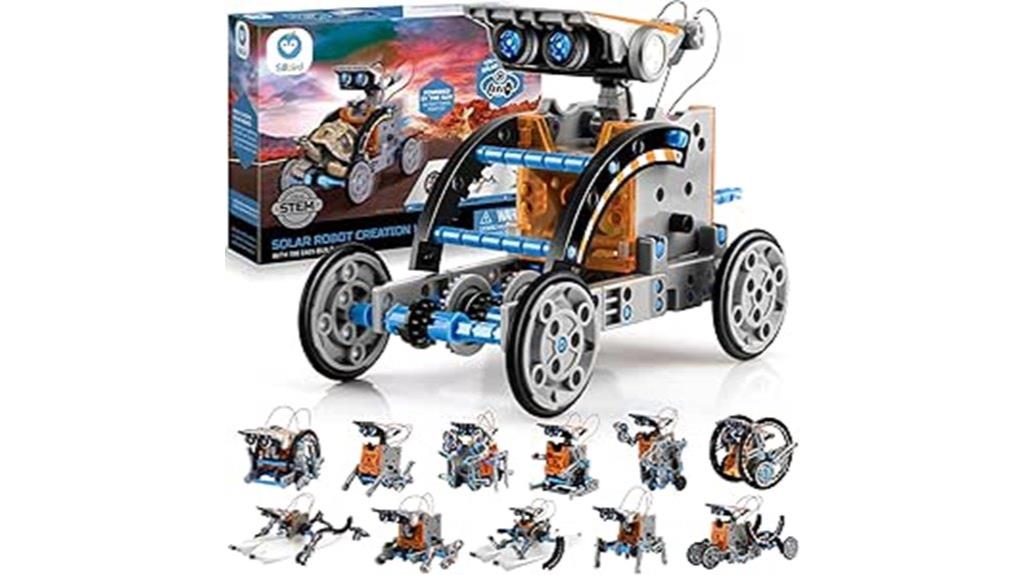
The Sillbird 12-in-1 Solar Robot Building Kit is an excellent choice for kids aged 8 to 13 who enjoy hands-on STEM activities and want to explore renewable energy concepts. With 190 pieces, it allows children to build 12 different models, from robots to cars, fostering creativity and engineering skills. Powered by a solar panel, it introduces renewable energy principles, especially during outdoor play. The clear instructions support independent assembly, making it a fun, screen-free activity. While the kit encourages curiosity about sustainability, some parts can be tricky to handle, and solar functionality depends on sunlight. Overall, it’s a versatile tool for engaging young minds in science and engineering.
Best For: children aged 8 to 13 who enjoy hands-on STEM projects, robotics, and exploring renewable energy concepts.
Pros:
- Promotes creativity, engineering skills, and understanding of renewable energy through multiple build options.
- Supports independent learning with clear step-by-step instructions and encourages family bonding.
- Serves as an educational tool that stimulates curiosity about sustainability and science.
Cons:
- Assembly can be challenging due to small parts and sometimes poorly fitting components.
- The solar panel’s effectiveness is weather-dependent, limiting functionality indoors or on cloudy days.
- Some parts are fragile, and the instructions may be confusing for younger children, leading to frustration.
Klever Kits 36-in-1 Motor Robotic Kits for Kids

Klever Kits 36-in-1 Motor Robotic Kits is an excellent choice for kids aged 8-13 who love hands-on, STEM-focused activities. With the ability to build 36 different robots, including racing cars and walking machines, it sparks creativity and curiosity. The set promotes understanding of science, engineering, and mechanics while developing problem-solving and logical thinking skills. All parts are neatly organized in a tray, making setup and cleanup easy. The included full-color booklet and video tutorials guide kids through each build, ensuring success regardless of skill level. Made from safe, durable materials, this kit makes a perfect gift for curious young minds enthusiastic to explore technology.
Best For: kids aged 8-13 who enjoy hands-on STEM activities, creative robot building, and learning about engineering concepts.
Pros:
- Offers 36 different robot designs including motorized models like racing cars and walking machines, fostering creativity and problem-solving skills.
- Comes with organized parts, a full-color instruction booklet, and video tutorials for easy, successful building experiences.
- Made from high-quality, durable, and safe materials, making it an excellent gift for young tech enthusiasts.
Cons:
- Requires some adult supervision for younger children during assembly.
- May be limited in complexity for older or more advanced builders.
- The need for batteries (not included) might be an extra step for initial setup.
Poraxy 4-in-1 STEM Kits for Kids Ages 8-13
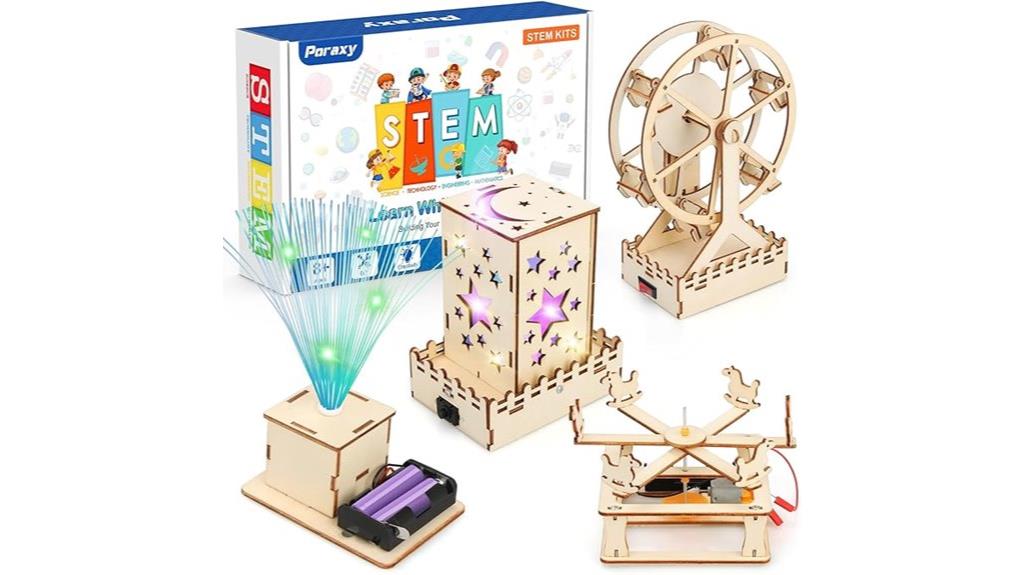
Poraxy’s 4-in-1 STEM Kits are perfect for kids aged 8 to 13 who enjoy hands-on learning and creative projects. These kits include parts to build mini ferris wheels, carousels, fiber optic lamps, and star night lights, making them ideal gifts for children within this age range. Crafted with high-quality, laser-cut wooden pieces, they guarantee sturdy, precise assembly. Kids can paint and decorate their models, adding a personal touch. The fiber optic and LED lights create magical, colorful atmospheres, inspiring imagination. Not only do these kits foster creativity, but they also support STEM learning by introducing concepts in engineering, circuits, and design.
Best For: children aged 8-13 who enjoy creative, hands-on STEM projects that combine learning with fun, and gift-givers seeking educational and engaging presents for kids within this age range.
Pros:
- Made with durable, high-quality laser-cut wooden components for precise and sturdy assembly
- Includes colorful fiber optic and LED lights to create enchanting visual effects and foster imagination
- Encourages development of STEM skills such as engineering, circuits, and design through interactive building activities
Cons:
- May require adult supervision for younger children during assembly and decoration
- Some parts may be small and pose a choking hazard for very young children under 6
- The complexity of certain projects might be challenging for children at the lower end of the age range without guidance
Snap Circuits Classic SC-300 Electronics Kit
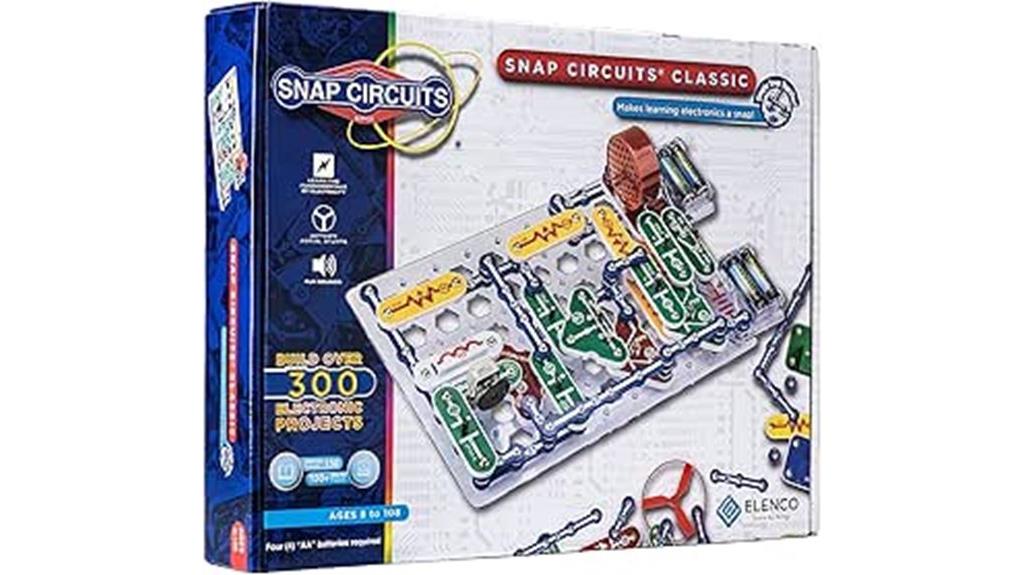
If you’re looking for an engaging way to introduce kids aged 8 and up to electronics, the Snap Circuits Classic SC-300 is an excellent choice. It features over 60 color-coded, real circuit components that snap onto a plastic grid, allowing kids to build over 300 projects like radios, burglar alarms, and flashlights. The kit promotes hands-on learning about electricity and circuits while developing skills in following instructions and creative problem-solving. With easy-to-understand manuals and expandable options, this kit offers a structured yet flexible learning experience. It’s perfect for fostering curiosity and understanding of everyday electronic devices in a fun, safe way.
Best For: children aged 8 and up interested in hands-on STEM learning and exploring electronics through building real circuit projects.
Pros:
- Over 60 color-coded, real circuit components that snap together easily without tools or soldering.
- Offers 305 educational projects that progressively increase in complexity, fostering skill development.
- Upgradable to more advanced kits like Snap Circuits Pro and Extreme for extended learning.
Cons:
- Requires four AA batteries (not included), which may be an inconvenience for some users.
- Larger projects or more advanced kits may require additional purchase of upgrade packs.
- Some young children may need supervision to ensure safe handling of small parts and components.
Learning Resources STEM Explorers Pixel Art Challenge
Looking for a fun, hands-on way to introduce young children to STEM concepts? The Learning Resources STEM Explorers Pixel Art Challenge is perfect. It combines art, math, coding, and problem-solving through colorful foam pieces and engaging challenges. Designed for kids ages 5-8, it promotes spatial reasoning, fine motor skills, and critical thinking. With over 40 screen-free activities, children follow coordinates and create designs like ladybugs or watermelons, gradually increasing difficulty. The set’s sturdy foam pieces are safe and durable, making it suitable for independent play. It’s a fantastic way to turn craft time into educational fun while fostering early STEM interest.
Best For: young children aged 5-8 who are beginning to explore STEM concepts through hands-on, screen-free activities that combine art, math, and problem-solving.
Pros:
- Encourages development of fine motor skills, spatial reasoning, and critical thinking
- Includes over 40 progressively challenging, screen-free activities for independent play and learning
- Durable, colorful foam pieces that are safe and easy for young children to manipulate
Cons:
- Some users have noted foam quality issues, such as pieces fitting poorly or being lightweight
- Limited variety of challenge types may require additional activities for advanced learners
- Storage solutions could be larger or more organized to accommodate multiple sets and accessories
60+ Science Experiment Kit for Kids

Are you searching for an engaging way to spark your child’s curiosity about science? I highly recommend the 60+ Science Experiment Kit for Kids aged 5-8. It offers over 60 fun experiments like volcanic eruptions, dinosaur digs, and lava lamps, all designed to make learning hands-on and exciting. The kit includes everything needed—materials, tools, safety goggles, and clear instructions—so kids can explore independently or with help. It promotes critical thinking, observation, and problem-solving skills while making science accessible and enjoyable. Perfect as a gift or weekend activity, this kit nurtures a lifelong love of STEM in young learners.
Best For: parents, teachers, or caregivers looking to provide children aged 5-8 with a comprehensive, engaging introduction to science and STEM learning through fun, hands-on experiments.
Pros:
- Contains over 60 diverse and exciting experiments that foster curiosity and learning
- All necessary materials, tools, and safety goggles are included for easy, independent exploration
- Promotes critical thinking, observation, and problem-solving skills in young learners
Cons:
- May require adult supervision for some experiments to ensure safety
- The extensive variety of experiments might be overwhelming for some children or caregivers
- The kit’s durability depends on proper storage and handling of the included materials
Dan&Darci Light-Up Terrarium Kit for Kids

The Dan&Darci Light-Up Terrarium Kit for Kids is an excellent choice for young science enthusiasts who love hands-on projects that combine learning and creativity. It offers a fun way to build a miniature garden inside a jar, complete with LED lighting that glows at night. The kit includes everything needed—seeds, soil, rocks, miniatures, and decorating stickers—making setup straightforward. Kids can explore plant growth, ecosystems, and responsibility by watering and caring for their plants. The rechargeable light adds an enchanting touch, turning the terrarium into a magical display. It’s a perfect mix of science, art, and responsibility, engaging children in a memorable, educational experience.
Best For: children aged 6-12 who enjoy hands-on science projects, creative decorating, and learning about plant growth and ecosystems.
Pros:
- Engages kids with a fun, educational STEM activity that promotes responsibility and patience.
- Includes all necessary components for easy setup and decorating, with clear instructions.
- The LED-lit lid creates a magical glow at night, enhancing the visual appeal of the mini garden.
Cons:
- Recharge time for the LED light can be lengthy (2-3 hours for about 4 hours of use).
- Some users experience initial issues with the LED light not functioning properly, though customer service often resolves these.
- The plastic jar and miniatures may feel less durable or premium, which could be a concern for some users.
Creativity for Kids Grow N Glow Terrarium Kit

If you’re searching for a hands-on STEM activity that sparks both creativity and curiosity, the Creativity for Kids Grow N Glow Terrarium Kit is an excellent choice for children ages 6 and up. This kit lets kids craft a mini ecosystem by planting organic chia and wheatgrass seeds in a plastic terrarium jar, which they can watch grow in just a few days. It includes glow-in-the-dark forest figurines and decorative items, making the experience both educational and fun. Kids learn about plant growth, responsibility, and nurturing skills while creating a glowing nighttime scene. It’s a perfect blend of science, arts, and crafts that fosters confidence and creativity.
Best For: children ages 6 and up who enjoy hands-on science, arts, and crafts projects that promote creativity, responsibility, and learning about plant growth.
Pros:
- Engages kids with a fun, glow-in-the-dark gardening activity that combines science and art
- Includes all necessary materials for multiple planting cycles, making it reusable and educational
- Promotes fine motor skills, nurturing responsibility, and confidence through hands-on building and caring for plants
Cons:
- Requires some adult supervision for younger children when watering or handling small parts
- Limited to growing organic chia and wheatgrass, which might not appeal to all children’s interests
- The glow-in-the-dark feature depends on light exposure and may diminish over time
National Geographic Chemistry Set with 45 Experiments for Kids

Young aspiring scientists will find the National Geographic Chemistry Set with 45 experiments to be an excellent choice, especially for kids aged 8 to 12 who love hands-on learning. This kit offers a variety of engaging activities like building volcanoes, creating geysers, and launching rockets, all designed to make chemistry fun and accessible. The included clear, illustrated guide helps kids understand scientific concepts while performing each experiment safely. It promotes critical thinking, problem-solving, and curiosity about STEM fields. Made with high-quality materials and backed by excellent support, this set provides hours of educational entertainment, inspiring young minds to explore the wonders of chemistry.
Best For: young children aged 8 to 12 who are interested in hands-on science experiments and want to explore chemistry in a fun, safe, and educational way.
Pros:
- Engages kids with 45 exciting experiments like volcano building and rocket launching.
- Comes with a clear, illustrated guide that makes learning scientific concepts easy and enjoyable.
- Made from high-quality materials and supported by excellent customer service, ensuring durability and satisfaction.
Cons:
- May require adult supervision for younger children to ensure safety during experiments.
- Limited to the experiments included; not expandable with additional kits or materials.
- Some activities may take time and space, which could be challenging in smaller environments.
6-in-1 STEM Kits for Kids Aged 8-12
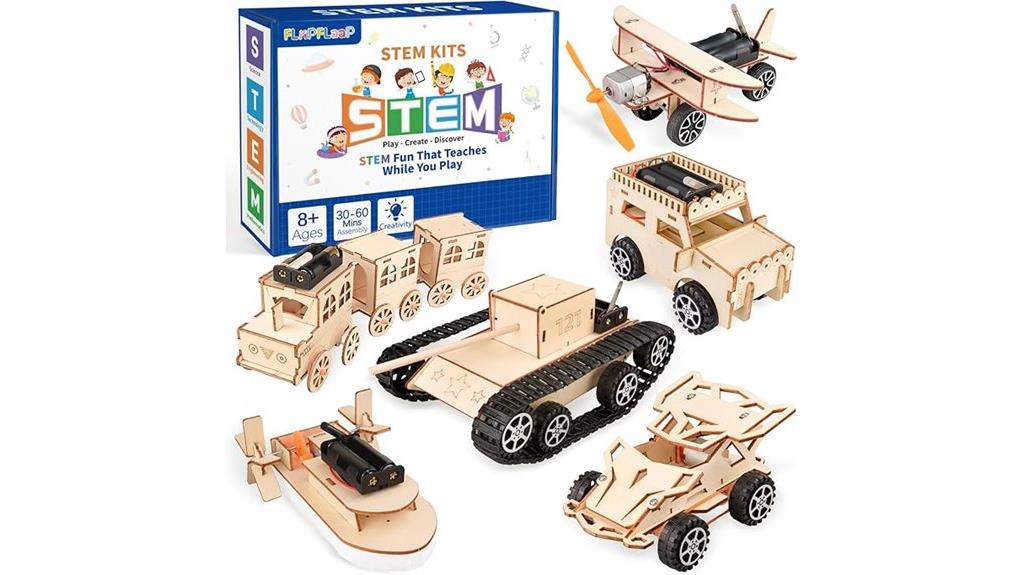
Looking for a versatile STEM kit that keeps kids engaged and learning? The 6-in-1 STEM Kits for Kids Ages 8-12 offer six different models, providing a variety of hands-on engineering and science activities. Perfect for children aged 8 to 13, it makes an excellent gift for birthdays or holidays. Kids can explore physics concepts like motion, energy transfer, and electricity through fun experiments, while parents and children bond over assembly and problem-solving. Made from durable, child-safe wooden components, the kit promotes interactive learning, reduces screen time, and sparks curiosity—making STEM education both fun and memorable.
Best For: parents, teachers, or caregivers seeking an engaging, educational STEM activity kit for children aged 8-13 that promotes hands-on learning and quality bonding experiences.
Pros:
- Offers six different models for diverse STEM exploration, keeping kids engaged and curious.
- Made from durable, child-safe wooden components that are easy to assemble.
- Encourages teamwork and problem-solving skills while reducing screen time.
Cons:
- Requires AA batteries (not included) for some models, which may be an additional purchase.
- Assembly may be challenging for younger children within the age range without adult assistance.
- The size of the kit and components might require sufficient storage space.
Smartivity Mega 150 Science Experiment Kit for Kids
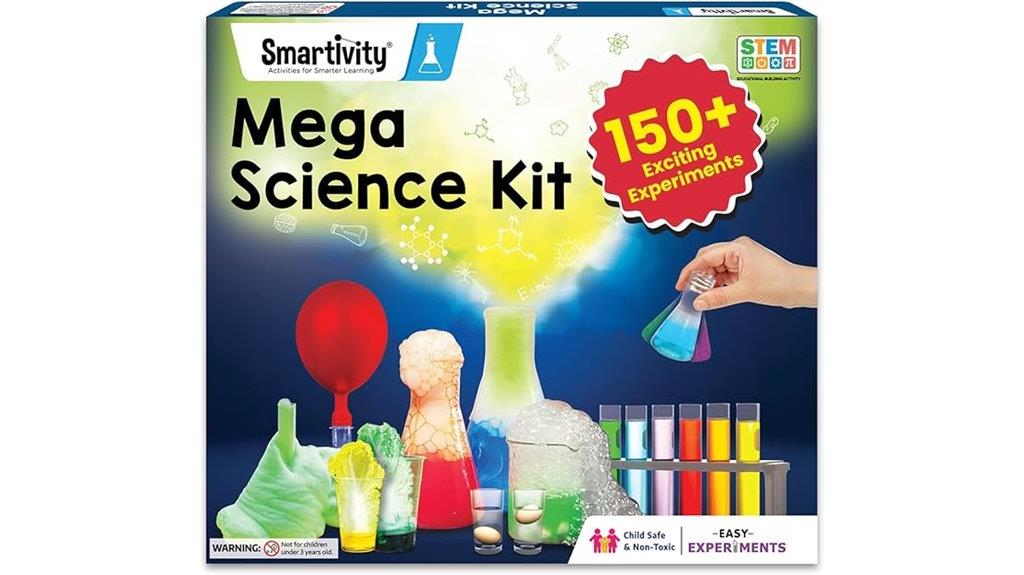
The Smartivity Mega 150 Science Experiment Kit for Kids stands out as an ideal choice for children aged 6 to 12 who are enthusiastic to explore chemistry and science through hands-on activities. With 150 experiments, it offers a thorough and engaging way to foster curiosity, critical thinking, and creativity. Developed by experts and tested over 1000 hours, the kit includes all necessary materials and easy-to-follow instructions. It encourages practical skills like measuring, pouring, and mixing while making science fun. Trusted worldwide and recognized with awards, it’s perfect for young learners eager to discover natural phenomena and develop a lifelong interest in STEM.
Best For: children aged 6 to 12 who are eager to explore chemistry and science through engaging, hands-on experiments.
Pros:
- Offers 150 comprehensive and exciting science experiments to foster curiosity and critical thinking
- Developed by experts with over 1000 hours of testing, ensuring quality and safety
- Includes all necessary materials with easy-to-follow instructions, making it suitable for young learners and STEM education
Cons:
- Some users have reported packaging issues leading to damaged or missing components
- Occasionally, components may leak or be incomplete, affecting the experiment experience
- The size and variety of experiments may require considerable space and time to complete fully
STEM 13-in-1 Solar Power Robotics Kit for Kids

If you’re searching for a hands-on STEM activity that combines fun with learning, the STEM 13-in-1 Solar Power Robotics Kit is an excellent choice for kids aged 8 to 12. It includes 13 different robot models built with easy-to-follow instructions, encouraging creativity and problem-solving. These robots can move on land or water, powered by solar energy, which introduces kids to renewable energy concepts. Made from safe, non-toxic materials, the kit is designed for safe play and easy disassembly. It’s perfect for parent-child projects, fostering curiosity about science and engineering while making learning interactive and engaging.
Best For: parents and educators seeking an engaging, educational STEM activity for children aged 8-12 that combines hands-on building, renewable energy learning, and creative play.
Pros:
- Encourages creativity, problem-solving, and engineering skills through building 13 different robot models.
- Promotes learning about solar energy and sustainability in a fun, interactive way.
- Made from safe, non-toxic materials with easy disassembly, ideal for young children and family projects.
Cons:
- Requires adult supervision or assistance for younger children during assembly.
- Limited to solar power, which may affect performance in low-light environments.
- The variety of models may be overwhelming for some children to complete independently.
Poraxy 5-in-1 STEM Kits for Kids Age 8-13

Poraxy’s 5-in-1 STEM Kits are an excellent choice for kids aged 8 to 13 who want to explore engineering and science hands-on, all while having fun. This versatile kit includes five different model cars, electrical components, wooden 3D puzzles, and building parts, providing an extensive STEM experience. Kids can assemble, paint, and decorate each project, fostering creativity and practical skills. Made from high-quality, non-toxic materials, the kit promotes learning about mechanics, circuits, and coding. Whether at home, school, or in clubs, it’s a perfect gift for curious minds ready to immerse themselves in engaging, educational projects that develop problem-solving and coordination skills.
Best For: curious children aged 8 to 13 interested in hands-on STEM learning, building, and creative decorating projects.
Pros:
- Includes a variety of models and educational components to promote comprehensive STEM exploration
- Made from high-quality, non-toxic materials ensuring safety and durability during use
- Encourages creativity through painting and decorating, making each project unique
Cons:
- Some wooden parts may be fragile and require careful handling during assembly
- Non-labeled bags can make sorting parts challenging for younger children
- Complex steps may require adult assistance for younger or less experienced builders
Factors to Consider When Choosing Educational STEM Kits for Kids
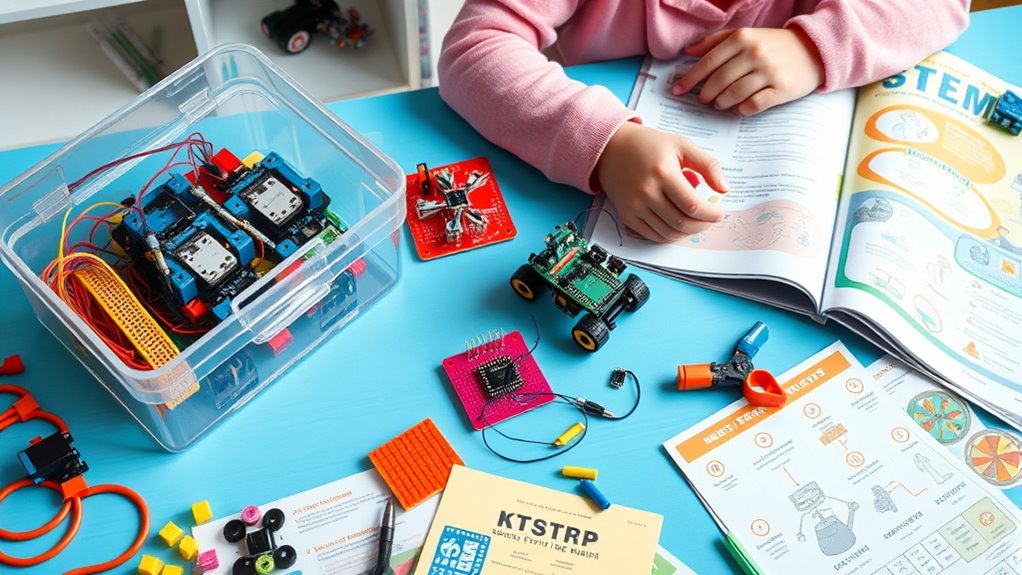
When choosing a STEM kit for a child, I always consider if it’s suitable for their age and skill level to keep them engaged without frustration. Safety standards and quality materials are also essential to guarantee they can explore confidently and safely. Finally, I look at the educational content and durability to make sure the kit provides value and lasts through multiple projects.
Age Appropriateness
Choosing the right STEM kit for a child depends heavily on age considerations, ensuring the activities match their developmental stage and motor skills. I always check the packaging for the recommended age range, as it helps match the kit’s complexity to the child’s abilities. For younger kids (ages 5-7), I look for simple projects with larger parts and easy-to-understand instructions, while for older children (ages 8-13), I prefer more challenging, multi-step experiments. Safety is essential, so I verify that kits for younger children have no small parts that could be a choking hazard and that all materials are non-toxic and child-safe. Appropriately matched kits keep learning fun, engaging, and safe, preventing frustration or boredom.
Skill Level Match
How can you guarantee a STEM kit matches a child’s current skill level? First, check that the recommended age range aligns with their developmental stage. Look for kits with varying difficulty levels so your child can progress comfortably. Clear instructions and tutorials tailored to their reading ability help assure they understand and stay engaged. Consider whether the kit includes open-ended projects, which foster creativity once foundational skills are mastered. Also, assess if the complexity of components and assembly fits their fine motor skills and attention span. Matching the kit’s challenge to their current abilities prevents frustration and promotes confidence. As they improve, you can introduce more advanced projects, keeping learning fun and adaptive to their growth.
Safety Standards
Ensuring a STEM kit meets safety standards is essential for a child’s well-being during play and learning. I always check that the kit complies with recognized safety certifications like ASTM, CE, or CPSIA, which ensure non-toxic materials and safe construction. I pay close attention to small parts, ensuring they’re securely attached and marked as age-appropriate to avoid choking hazards for younger children. It’s also important to verify that the packaging includes safety warnings and clear instructions for proper handling. I look for kits made from durable, non-toxic plastics, free of sharp edges or toxic paints that could cause harm. Finally, I seek products endorsed by reputable safety organizations, confirming they’ve undergone rigorous safety testing for peace of mind.
Educational Content
When selecting an educational STEM kit for kids, I focus on whether it provides clear, age-appropriate instructions that gradually introduce new concepts. Well-structured manuals help children build confidence as they progress, making learning engaging rather than overwhelming. I also look for kits that cover core STEM principles like circuitry, physics, chemistry, engineering, or coding, offering hands-on activities that reinforce theoretical ideas. Visual aids and detailed illustrations are essential—they make complex steps easier to follow and boost understanding. A good kit encourages critical thinking, experimentation, and problem-solving, inspiring kids to explore beyond predefined projects. Including real-world applications and multidisciplinary activities helps children see the relevance of STEM in everyday life, deepening their interest and comprehension.
Material Durability
Durable materials are essential when choosing educational STEM kits for kids, as they determine the product’s longevity and safety. High-quality plastics, metals, or treated wood guarantee the kits can withstand repeated handling and assembly. Using non-toxic, child-safe materials not only keeps kids safe but also helps prevent breakage and deterioration over time. Reinforced components and sturdy construction reduce the risk of parts cracking, snapping, or wearing out after multiple uses. Properly manufactured materials also resist environmental factors like moisture, heat, and impact, extending the kit’s lifespan. By investing in well-made, durable materials, you minimize the need for replacements, ensuring the ongoing educational value and safety of the kit. Durability is key to a long-lasting, engaging learning experience.
Project Variety
Have you ever considered how a STEM kit’s project variety can impact a child’s learning experience? A diverse range of projects keeps children engaged by offering multiple activities suited to different interests and skill levels. When a kit includes options like circuits, robotics, chemistry, and engineering, kids gain a well-rounded understanding of STEM concepts. Including both simple and complex projects allows children to build confidence gradually while tackling more challenging tasks. Plus, a kit with various project types encourages creativity and innovation, giving kids the freedom to modify or invent their own designs. Exposure to a broad spectrum of activities not only sparks curiosity but also motivates kids to explore different science and technology fields, making learning fun and continuously inspiring.
Expansion Potential
Ever wonder how to guarantee a STEM kit remains engaging as your child’s interests and skills grow? The key is choosing kits with expansion potential. These kits allow kids to build on their foundational skills and explore more complex projects over time. Compatibility with upgrade sets or additional modules means the kit can evolve, keeping children challenged and interested. Having access to expansion components encourages continuous learning and skill development, preventing boredom. Modular designs or upgrade paths make it easier for parents to invest in a versatile tool that adapts to their child’s changing abilities. Plus, many kits include instructions or accessories for new projects, fostering creativity and problem-solving beyond initial activities. This ensures the learning journey remains dynamic and rewarding as your child grows.
Frequently Asked Questions
What Safety Features Should I Look for in STEM Kits for Young Children?
When choosing STEM kits for young children, I look for safety features like non-toxic materials and sturdy, child-safe components. I also check for small parts that could be a choking hazard and make sure the kit has clear, age-appropriate instructions. It’s important that the tools are easy to handle and that the kit complies with safety standards. These features give me peace of mind while my child explores and learns.
How Do STEM Kits Promote Long-Term Interest in Science and Engineering?
STEM kits promote long-term interest in science and engineering by making learning hands-on and exciting. I find that when kids can experiment and see real-world results, they develop curiosity and confidence. These kits often include projects that challenge them just enough, encouraging problem-solving and perseverance. As they succeed and discover new things, their passion for STEM grows, inspiring them to explore careers and continue learning well beyond childhood.
Are There Any Age-Specific Considerations for Selecting STEM Kits?
Think of choosing a STEM kit like picking the perfect key for a lock—age matters! I always consider a child’s developmental stage, interests, and skill level. For younger kids, simple, colorful kits spark curiosity, while older kids crave more complex projects that challenge their thinking. Matching the kit to their age ensures they’re engaged, confident, and enthusiastic to explore more—making STEM learning a truly fun adventure.
Can STEM Kits Be Used for Group Learning or Classroom Activities?
Absolutely, STEM kits are perfect for group learning and classroom activities. I’ve seen kids collaborate on experiments, sharing ideas and solving problems together, which boosts teamwork and communication skills. These kits are designed to be versatile, so they work well for small groups or entire classrooms. I recommend selecting kits with multiple components to guarantee everyone can participate and stay engaged, making learning both fun and effective.
What Are the Best Ways to Supplement STEM Kits With Additional Educational Resources?
Think of STEM kits as the seed, and additional resources are the nourishing rain. I supplement these kits with online tutorials, educational videos, and interactive apps to deepen understanding. Books on science and engineering spark curiosity, while local museums or science centers offer real-world experiences. Combining hands-on activities with digital and experiential resources makes learning more engaging and memorable, turning every project into a journey of discovery.
Conclusion
Choosing the right STEM kit can truly spark a child’s curiosity and passion for science. Remember, “Give a kid a fish, and you feed them for a day; teach them how to build a robot, and they’ll learn for a lifetime.” So take your time, consider their interests, and pick a kit that inspires hands-on learning. When you foster that curiosity, you’re planting seeds for a future full of discovery and innovation.









